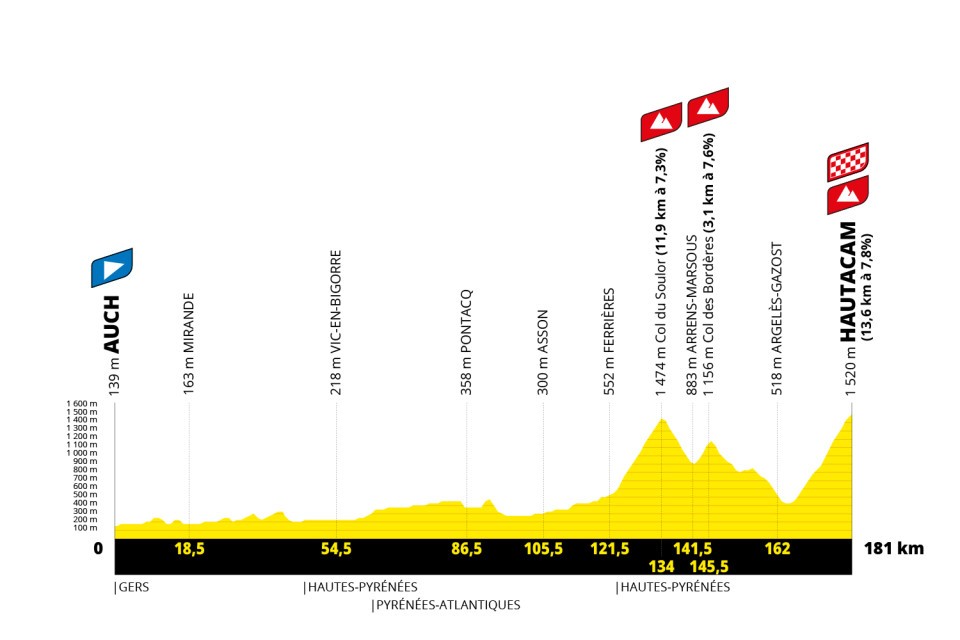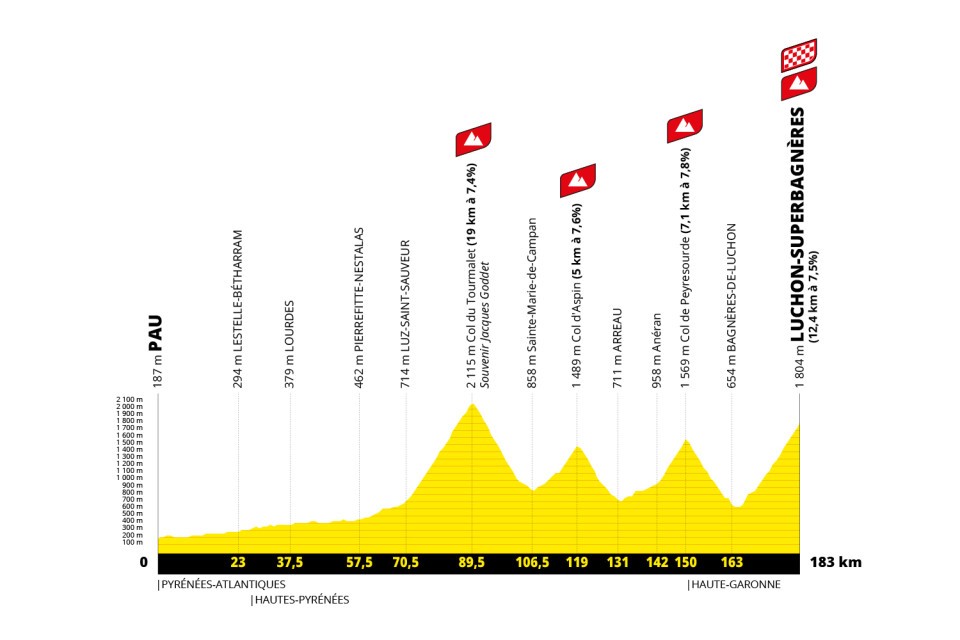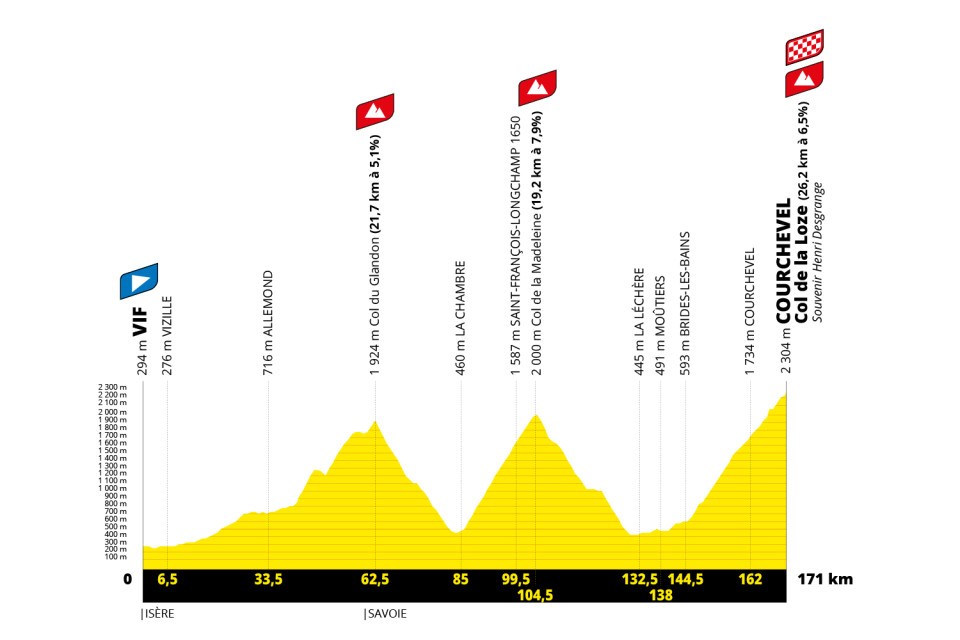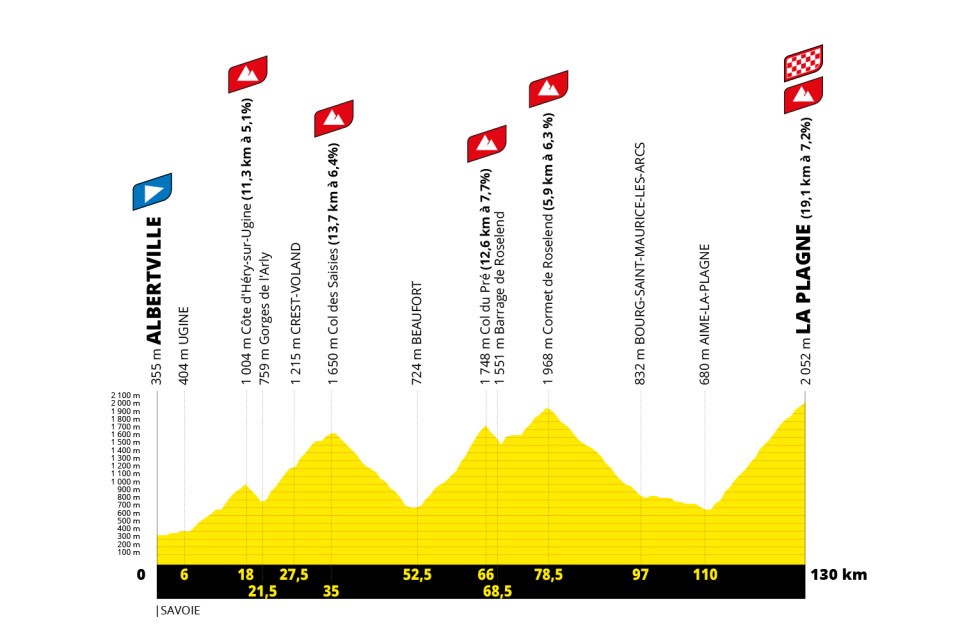11 days cycling, 1 rest day, 1,483km
See how the pros roll! Eleven full stages where history is made provide a challenge you’ll remember for a long, long time.
If you’re not so keen on climbing, look away! It’ll be a fantastic Tour to watch because the pros are going to have some big battles – but for us amateurs, it’s also extremely well balanced…
Alongside the big, brutal boast-about-them (or live in fear of them!) stages (14, 18, 19) are a blessedly short mountain Time Trial (13), a couple of flat-first-three-quarters stages (12, 16) and two gentle transition stages (15, 17). This is a lovely flow and will keep spirits high and cycling joy constant.
The 2025 mountain stages are characterised by big names rather than Tour-firsts; a chance to tick of plenty of bucket list climbs and to ride deep into both the Pyrenees and the Alps. This really is a road trip where you’ll have an extraordinary sense of achievement by the end… and what better way to celebrate and reflect than with a trip up the Champs Elysees!
Itinerary
Wed 9th July: Travel under own arrangements to Toulouse hotel by 7pm. Meet the team, meet your fellow cyclists, arrival briefing and dinner
Thursday 10th – Sun 20th July : Cycle stages 12-21
Mon 21st July: Depart after breakfast, under own arrangements from Paris hotel.
Stage 12 – Auch to Hautacam – 181km. Thurs 10th July
Total Climb: 3,850m
Today’s stage is a tale of two chainrings. We have around 100km of relatively flat riding, to get us to the start of the Soulor climb at Ferrières, during which we can gear up, get into formation, and draft each other along the plane tree avenues of Occitanie, watching the mountains draw closer and closer on the horizon. Then the climbing starts, and we all click down into the easiest gear we can find, the better to haul ourselves over the three Pyreneen giants (of increasing gradient) that lie ahead.
First is the Col du Soulor, whose occasional 9% sections can’t quite detract from the fact that this is a beautiful climb. A quiet strip of tarmac wiggles its way up out of the leafy valley, and slowly takes you higher and higher up the side of the mountain, until you’ve left the trees behind, and are at eye level with the magnificent peaks that surround us. Welcome to the Pyrenees.
From here there’s a quick descent to the start of Col des Bordères, which is slightly steeper, but mercifully shorter, and has an enticing ‘back road’ feel. And then, after around 17km of descent, we meet the big one: Hautacam, a 13km monster, that steepens cruelly in its higher stretches, and delivers you to a high, windswept finale.
The top of the Hautacam has very little infrastructure so you’re really arriving to a couple of sheds in a field – but what a field! Hautacam (originally just a ski station but with a recent diversification project aimed at making it a year-round destination) is famed for its panoramic views which you’ll want to savour before you roll back down the hill to our hotel for the night.
Tour logisitics
Start: Transfer to Auch
Finish: Cycle back down from Hautacam to our hotel in Argeles Gazost
Stage 13 – Loudenvielle to Peyragudes – 11km. Fri 11th July
Total Climb: 650m
Short and sublime, this 11km ride takes us from the pretty lakeside town of Loudenvielle, up a whopping 650m to the vertiginous altiport at Peyragudes, famous for appearing in a James Bond film in 1997, and for terrorising the quads of the pro peloton with its gradients.
Luckily we’re not racing (or are you?!), and a shorter stage gives us plenty of time to appreciate the panoramic views of the Louron valley as we ascend past its fragrant meadows on immaculate tarmac. The road steepens in its final kilometres, and the small resort of Peyragudes is visible for a long time as we battle our way towards it up the 15% final slope. This being a shorter day, there’s plenty of time at the top to breathe the sweet mountain air and admire the line of peaks stretching away towards the Spanish border.
Tour logisitics
Start: Transfer to Loudenvielle
Finish: Transfer after the Time Trial to Pau
Stage 14 – Pau to Luchon-Superbagnères – 183km. Sat 12th July
Total Climb: 4,950m
Today we ride a replica of Stage 14 from 1986, where Greg Lemond turned the tables on Bernard Hinault and went on to win the Tour. It’s a challenging stage, with almost 5,000m of ascent, the majority of which is packed into its second half – so we depart Pau on relatively flat roads, following the Gave de Pau river south towards the mountains. After admiring the fairytale architecture of Lestelle-Bétharram and the pilgrimage sites of Lourdes, we begin to gain height, and the mountains close in around us as we approach Luz-Saint-Sauveur, where our longest climb of the day begins.
The road up to the Col du Tourmalet is long, and very steep in places, with the highest gradients in its final stretches. It’s never a boring view though with open vistas of the road wiggling up ahead of you to the col. We recommend you take it steadily and adopt a gear that (if possible) makes it almost feel easy; there’s still a lot to come of this stage and you’ll need to remember that the Tourmalet is the first, not the last, of four!
At the top we’ll have a moment to savour the triumph of completing one of the Tour’s most famous climbs, and then there’s a long descent to enjoy, via the brutalist ski resort of La Mongie. Next we climb up out of the remote Payolle valley, to the ethereal Col d’Aspin: a much shorter ascent than the Tourmalet, though it’s slightly steeper.
Descending to Arreau, we then follow the Louron towards the base of the Peyresourde. It’s worth remembering that this valley has an elevation gain of 400m in 12km, so it may feel like a struggle, even if it appears to be flat. The struggle will intensify on the 7km climb up to the col, but we’ll be rewarded with panoramic views, and the excitement of descending into a new valley, via the Peyresourde’s scenic hairpins, and its famous avenue of trees. Passing through the stylish spa town of Bagnères-de-Luchon, we then commence our 12km ascent to Superbagnères: through the narrow Lys valley, and then along an increasingly exposed series of switchbacks until we finally put a foot down on the summit, with mountains rolling away on all sides of us.
It’s worth noting that we pass our hotel on the way to the final climb and you’re welcome to stop if you’ve run out of beans.
Tour logisitics
Start: Pau hotel
Finish: Luchon hotel
Stage 15 – Muret to Carcassonne – 169km. Sun 13th July
Total Climb: 2,400m
Our first hour takes us between two rivers, as we set off from the banks of the Garonne, and make our way across the watershed towards the Ariège, which we’ll meet at Auterive – an important crossing point since Roman times. We now encounter a few minor bumps as we cross the low plateau that overlooks the eastern bank of the Ariège, and descend to cross the Canal du Midi at Villefranche-de-Lauragais, best known for its historic production of pastel – a blue dye that the British might recognise as woad.
Another hour or so of quiet countryside riding brings us to Revel, where we encounter our first significant climb of the day. The Côte de Saint-Ferréol takes us up out of the town, to a pretty lakeside settlement, and with an average gradient of just over 5%, it shouldn’t bother us too much. Our next challenge, the 10% Col du Pas du Sant, may cause a little more trouble, but it takes us into the fascinating Montagne Noire – a remote highland region that was the site of significant Résistance activity during the Second World War. Look out for monuments to these brave fighters as you roll along the quiet tree-lined roads that eventually lead us south, towards the magnificent fortified city of Carcassonne. The final 40km of our ride is almost all downhill or flat, so you’ll be able to enjoy the way the landscape changes around you as you emerge from the Montagne Noire and catch sight of the vast plain on which the city lies, and the distant mountains on every horizon.
Tour logisitics
Start: Transfer to Muret
Finish: Carcassonne hotel
Rest Day – Mon 14th July
Following a morning transfer (not too early!) from Carcassonne to Montpellier, you’ll still have plenty of time for a huge lunch, some bike tinkering and a visit to the launderette
Tour logisitics
Morning transfer from Carcassonne to Montpellier . Overnight Montpellier
Stage 16 – Montpellier to Mont Ventoux – 172km. Tuesday 15th July
Total Climb: 2,900m
Everyone will focus on the fact that this stage finishes at the top of Mont Ventoux, but for most the day it’ll be a very different riding experience, with a gently rolling route that takes us through the delightful landscape of southern Provence. It’s an opportunity to enjoy one of France’s many cycling heartlands, and we’ll be treated to fields of lavender and rolling vineyards as we move into the fertile Rhône Valley. Provence has some of the world’s most impressive Roman remains, and the same golden stone has been used to build the region’s many hilltop villages, as well as larger towns, where you’ll want to slow down to savour the architecture.
It’s a day of many rivers: we leave Montpellier via the Lez (popular with canoeists), crossing the tranquil Vidourle at Quissac, and the Gardon at Moussac – but the one you’ll remember is the glistening Rhône, whose waters have defined this part of France for millennia. Wine buffs will be delighted to know that our route includes the village of Châteauneuf-du-Pape, where a dramatic hilltop castle overlooks world-famous vineyards, and most of our hearts will flutter as we catch our first glimpses of the Giant of Provence, looming above the lavender fields and tree-lined streets of Bédoin.
Ventoux isn’t just famous for its looks – the wind-blasted scree slopes and the red-and-white tower – it’s also one of the most challenging climbs of the Tour. The lower stretches hover around 9-10%, and although the gradient lessens slightly as you emerge from the trees at Chalet Reynard, you’ll then have the fearsome Provençal wind to contend with, plus the cruel kicker in the final 2km, where the road ramps back up to 9.5%. The views from the top will make it all worth the struggle, and you’ll want to linger here, to cheer on your fellow riders as they battle up to the summit.
Tour logistics
Start: Montpellier hotel
Finish: Malaucene (Ventoux) hotel
Stage 17 – Bollène to Valence – 161km. Wed 16th July
Total Climb: not yet published
Don’t get too complacent about this so-called flat stage. We’re too close to the mountains for the Tour to be able to resist adding a few lumps and bumps, though in many cases we’ll be riding between the hills rather than over them, making this a scenic ride that offers a lot of bang for relatively little buck.
The morning involves a fair bit more up than down but as Valence is only 60m higher in altitude than Bollene, the good news is that the latter half of the day will seem much easier on the legs.
Our morning ride takes us through the arid landscape of northern Provence, with wide views over sweeping vineyards and the occasional burst of yellow gorse. We steadily gain height (over 500m in the first 50km) as we move out of the Rhône valley and into the Baronnies Provençales. This small range of limestone mountains, perched on the edge of the Alps, is known for the wide variety of herbs that are grown and harvested here, so we can expect to inhale the scents of thyme, rosemary and lavender as we make our way through its quiet valleys.
We’ll briefly descend out of the hills for visits to the historic stone villages of Marsanne and Cléon-d’Andran, passing small hamlets and very few cars on the way. And then a scenic climb of around 5km takes us up the rim of the valley, and over the top via a luscious descent to the river Drôme. The rest of this stage will pass quickly as the final hour of the ride is on fast, flat roads, so you’ll arrive in Valence full of the joys of cycling .
Tour logistics
Start: Short transfer to Bollene
Finish: Valence hotel
Stage 18 – Vif to Courchevel Col de la Loze – 171km. Thursday 17th July
Total Climb: 5,500m
Welcome to 2025’s most demanding stage. It includes 5,500m of vertical gain, over three massive climbs, and finishes at the highest point of the whole Tour – the 2,304m Col de la Loze. You’re right to be nervous about tackling this monster, but what the route profile doesn’t tell you is how beautiful this ride will be, and how many happy memories you’ll take home with you.
Setting off from Vif, in the shadow of the Vercors massif, we’ll follow the Romanche river into the high mountains, beginning our first climb as we skirt the glittering Lac du Verney. The road up to the Col du Glandon passes through some of the wildest scenery you’ll see on this stage, following a narrow valley upwards until it emerges alongside another beautiful mountain lake. Look out for marmots as you leave the trees behind you and approach the windswept summit of this magnificent climb. The gradient varies significantly over 21km, and you’ll want to save some energy for kilometre 10, which averages 11%.
From here there’s around 25km of delightful downhill into the Maurienne Valley, and then with very little ado we set off up our next big ascent, towards the Col de la Madeleine. For better or for worse, this road offers fewer variations in gradient than the Glandon, so you may find it easier to get into a rhythm, but there’ll be fewer easy stretches to rest on. The col, when you reach it, is an exhilarating 2,000m above sea level.
After another long descent, and a 15km roll along the Isère valley to Brides-les-Bains, it’s time for the 26.2km up to the Col de la Loze, via Courchevel – a journey like no other, as you’ll ascend the best part of two vertical kilometres, from the bustling valley floor, to the rarefied atmosphere of the Tour de France’s highest point. The last 5km are closed to all traffic but bicycles, which should help to soften the blow of the 11% section you’ll meet shortly before the top.
The first time Le Loop rode up the Col de la Loze was in 2023 and our Alumni still talk, joke and cry about it. These may be some of the toughest kilometres you ever cycle but that’s no reason not to give it a go.
(As an aside, the route passes our Courchevel hotel on the way to the top so if you’ve already had plenty of challenge, you do have the option to stop).
Tour logistics
Start: Transfer to Vif
Finish: Courchevel hotel
Stage 19 – Albertville to La Plagne – 130km. Fri 18th July
Total Climb: 4,600m
The lofty ski resort of La Plagne is today’s grand finale, and there’s 4,600 ascent in total, but what you’ll really remember from this stage is the simple joy of cycling in the Alps – the green meadows, clamouring cowbells, and quaint wooden chalets lining the climbs.
Our first ascent, which we encounter around 10km in, is a relatively gentle one, up to the pretty village of Hery, which perches on the mountainside overlooking the Arly gorge. There’s only a brief descent before we’re straight into the next one – the super-pretty 13km climb up to Col des Saisies, a quiet road that twists its way through pine forests and green meadows.
After the descent comes Beaufort, a classic Alpine town famed for its cheese, and known as the gateway to one of the finest road cycling sequences there is –Cormet de Roselend via Col du Pré. The first of these climbs is a scenic-but-steep ascent on tranquil hairpins, serenaded by cowbells and overlooked by chalets. As we roll over the top we’ll be treated to views of the spectacular Lac de Roselend (everyone will want to stop for photos), before rolling downhill to cross its dam, skirt its northern shore, and begin our ascent of the famous Cormet, which at this time of year should be lined with delicate Alpine flowers.
The corkscrew descent to Bourg-Saint-Maurice is one of the most enjoyable in the Alps, and the valley that connects to La Plagne is slightly downhill too (hurrah!), so all you have to worry about now is riding uphill for 19km – the final big climb of this year’s Tour – and planning how you’ll celebrate when you reach the top.
Tour logistics
Start: Transfer to Albertville
Finish: Dinner at La Plagne, then transfer to Nantua hotel
Stage 20 – Nantua to Pontarlier – 185km. Sat 19th July
Total Climb: 2,850m
This punchy stage showcases the Jura – one of France’s lesser-known mountain ranges which, despite being effectively Geneva’s back yard, offers a hefty dose of that middle-of-nowhere feeling. Expect to see sheer limestone cliffs, long blue lakes, and low, leafy peaks that will feel very different from the jaggedness of the Alps.
The climbing starts shortly after we leave Nantua and we’ll spend a good hour working our way up the Col de la Croix de la Serra, a leafy climb that hugs the edge of the Semine gorge, and tops out at just over 1,000m. We’ll admire a cluster of distant peaks as we speed downhill into Saint-Claude, which claims to be the international capital of pipe smoking, and has the world’s largest pipe on display in the city centre.
Climbing up again, the route undulates scenically across the green Jura plateau, and pays a visit to the pretty lakeside town of Le Frasnois, before heading north toward the Côte de Thesy. This 3.5% climb has an average gradient of just over 8% (with some stretches of 11%), and takes us up to the quiet village of Thesy, from which, on a clear day, we may enjoy views of the distant Alps. There’s still plenty of climbing during the last couple of hours of the ride, as the route bends south towards Pontarlier, but the scenery remains pleasingly rural, and a small descent takes us out of the woods, and into the outskirts of the town.
Tour logistics
Start: Nantua hotel
Finish: Transfer to tonight’s hotel mid-way to Paris
Stage 21 – Mantes-la-Ville to Paris-Champs-Élysées – 100km. Sun 20th July
Total Climb: not yet published
Time for our lap of honour! We set out today from Mantes-la-Ville, a small town on the banks of the Seine to the west of Paris. It’s a lovely direction to approach the capital from as most of our ride will feel surprisingly rural. We roll through the pleasant farmland and scenic villages that surround the French capital, passing Versailles – our final château! – as we enter the city’s elegant suburbs. There’s one significant climb towards the end of the ride, but a brief glimpse of the Eiffel Tower on the descent will let us know we’re nearly there, and before we know it we’ll be riding up the sacred cobbles of the Champs-Elysées towards the Arc de Triomphe.
* Note that due to some major roads that we can’t close, we’ll adapt this route more than usual. We’ll also only do one lap of the final Paris circuit (rather than 10) – and then ride a couple of kilometres from the Arc de Triomphe to our Paris hotel.
Tour logistics
Start: 2.5hr transfer to Mantes la Ville
Finish: Cycle into Paris hotel ahead of evening celebrations
| Total Cost |
Deposit | Second Payment Due end Jan |
Final Payment Due end Mar |
Fundraising Target | 80% Fundraising Due end April |
|
£2740
|
£250 | £1400 | £1090 | £1500 | £1200 |
- Accommodation (Mostly twin share. Single supplements are subject to availability)
- All food (3 meals and the best feedstops you’ve ever seen)
- Fully signed route, the stuff of legend
- Mechanical, medical and moral support
- Luggage Transfers
- Coach transfers to the next stage start when the stages aren’t contiguous
- Travel to and from France (but we’ll give you advice on the best travel routes)
- Bike Transport (£50 each way if you want us to drive your bike there and back)
- Evening massage (£15 or €15 per massage if you’d like one – highly recommended)
- Beer/wine/drinks at dinner





